1982 North Indian Ocean cyclone season
The 1982 North Indian Ocean cyclone season was part of the annual cycle of tropical cyclone formation. The season has no official bounds but cyclones tend to form between April and December. These dates conventionally delimit the period of each year when most tropical cyclones form in the northern Indian Ocean. There are two main seas in the North Indian Ocean—the Bay of Bengal to the east of the Indian subcontinent and the Arabian Sea to the west of India. The official Regional Specialized Meteorological Centre in this basin is the India Meteorological Department (IMD), while the Joint Typhoon Warning Center (JTWC) releases unofficial advisories. An average of five tropical cyclones form in the North Indian Ocean every season with peaks in May and November.[1] Cyclones occurring between the meridians 45°E and 100°E are included in the season by the IMD.[2]
| 1982 North Indian Ocean cyclone season | |
|---|---|
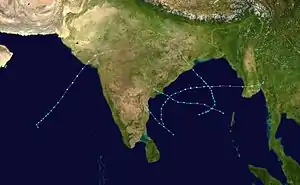 Season summary map | |
| Seasonal boundaries | |
| First system formed | April 30, 1982 |
| Last system dissipated | November 9, 1982 |
| Strongest storm | |
| Name | BOB 01 |
| • Maximum winds | 215 km/h (130 mph) (3-minute sustained) |
| • Lowest pressure | 940 hPa (mbar) |
| Seasonal statistics | |
| Depressions | 19 |
| Deep depressions | 11 |
| Cyclonic storms | 8 |
| Severe cyclonic storms | 5 |
| Very severe cyclonic storms | 4 |
| Extremely severe cyclonic storms | 3 |
| Super cyclonic storms | 0 |
| Total fatalities | 486 |
| Total damage | Unknown |
| Related articles | |
Systems
Extremely Severe Cyclonic Storm BOB 01
| Extremely severe cyclonic storm (IMD) | |
| Category 4 tropical cyclone (SSHWS) | |
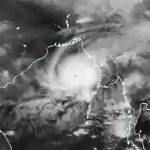  | |
| Duration | April 30 – May 5 |
|---|---|
| Peak intensity | 215 km/h (130 mph) (3-min) 940 hPa (mbar) |
On April 30 the monsoon trough spawned a tropical depression in the western Bay of Bengal. It tracked northeastward, becoming a tropical storm on the 1st and a cyclone on the 2nd. Its movement became more to the east, and the cyclone continued to quickly intensify, reaching a peak of 145 mph winds just before landfall. The small and compact cyclone hit southern Myanmar on the 4th, and it dissipated the next day over land. Moderate to heavy damage was experienced, but advance warning kept the death toll at only five.
Extremely Severe Cyclonic Storm BOB 02
| Extremely severe cyclonic storm (IMD) | |
| Tropical storm (SSHWS) | |
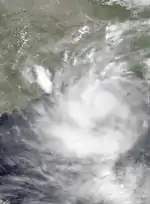  | |
| Duration | May 30 – June 4 |
|---|---|
| Peak intensity | 165 km/h (105 mph) (3-min) 952 hPa (mbar) |
Tropical Depression 2B developed from the monsoon trough in the central Bay of Bengal on May 30. It headed northeastward, becoming a tropical storm later that day and reaching a peak of 65 mph winds on the 31st. The storm turned to the northwest, where it weakened to a tropical depression. It restrengthened, and hit near Paradip, India on the 3rd as a 65 mph tropical storm. The storm brought heavy flooding amounting to 140 casualties and destroying over 500,000 homes.
Tropical Storm Three (3B)
| Severe cyclonic storm (IMD) | |
| Tropical storm (SSHWS) | |
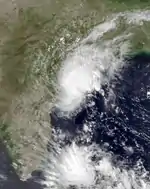  | |
| Duration | October 13 – October 16 |
|---|---|
| Peak intensity | 100 km/h (65 mph) (3-min) 986 hPa (mbar) |
Tropical Storm Three, which formed in the central Bay of Bengal on October 13, hit eastern India on the 16th as a 60 mph tropical storm.
Tropical Storm Four (4B)
| Severe cyclonic storm (IMD) | |
| Tropical storm (SSHWS) | |
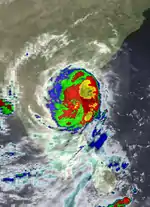  | |
| Duration | October 17 – October 19 |
|---|---|
| Peak intensity | 100 km/h (65 mph) (3-min) 982 hPa (mbar) |
An area of convection south of the previous storm slowly organized into a tropical storm on October 17. It tracked northwestward, reaching a peak of 60 mph winds before hitting southeastern India on the 18th as a weakened 50 mph storm. 5 casualties can be attributed to this system.
Extremely Severe Cyclonic Storm ARB 05
| Extremely severe cyclonic storm (IMD) | |
| Category 2 tropical cyclone (SSHWS) | |
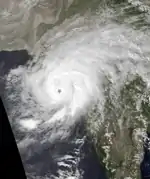  | |
| Duration | November 4 – November 9 |
|---|---|
| Peak intensity | 165 km/h (105 mph) (3-min) 952 hPa (mbar) |
The final storm of the season developed on November 4 in the central Arabian Sea. It tracked northeastward, strengthening into a tropical storm on the 6th and a cyclone on the 7th. The system peaked at 100 mph winds before hitting Veraval, India on the 8th. The cyclone rapidly dissipated, after resulting in 341 casualties and heavy flooding.
See also
- List of North Indian Ocean cyclone seasons
- 1983 Atlantic hurricane season
- 1983 Pacific hurricane season
- 1983 Pacific typhoon season
- Australian cyclone seasons: 1981–82, 1982–83
- South Pacific cyclone seasons: 1981–82, 1982–83
- South-West Indian Ocean cyclone seasons: 1981–82, 1982–83
References
- "Frequently Asked Questions: What is the annual frequency of Cyclones over the Indian Seas? What is its intra-annual variation?". Indian Meteorological Department. 2012. Archived from the original on May 21, 2015. Retrieved June 8, 2012.
- "Bulletins Issued by Regional Specialized Meteorological Centre (RSMC) - Tropical Cyclones, New Delhi" (PDF). India Meteorological Department. May 25, 2009. Archived from the original (PDF) on 2012-04-12. Retrieved July 16, 2012.